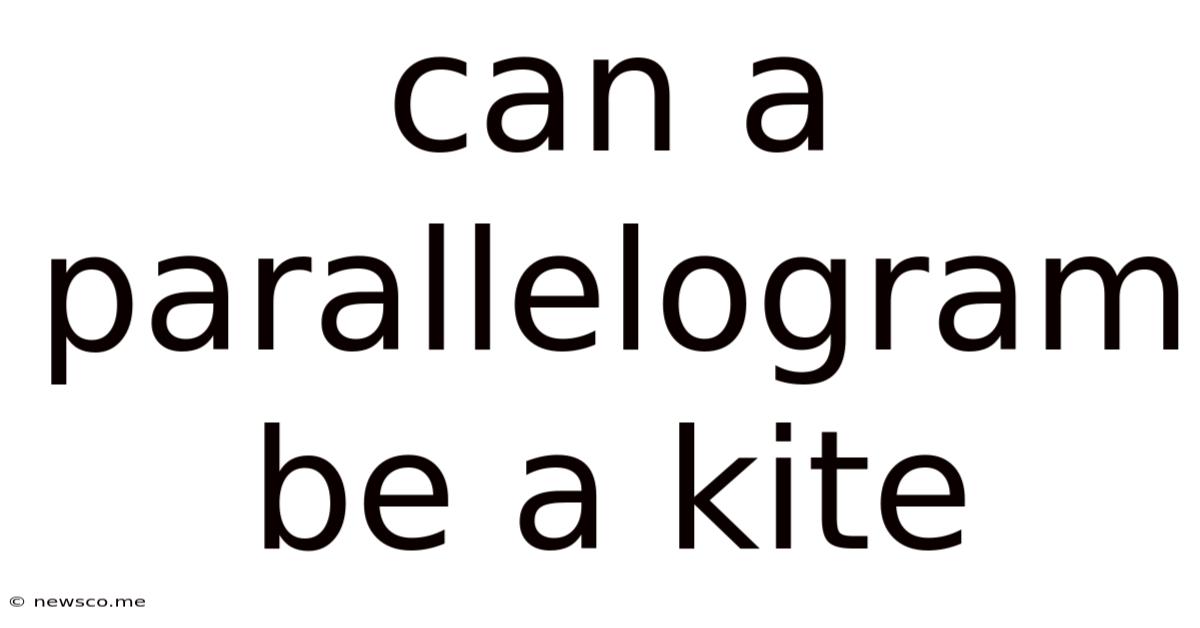Can A Parallelogram Be A Kite
News Co
Mar 21, 2025 · 4 min read

Table of Contents
Can a Parallelogram Be a Kite? Exploring the Overlap of Quadrilateral Properties
The world of geometry is full of fascinating shapes, each with its own unique set of properties. Understanding the relationships between these shapes, especially those that share common characteristics, can deepen our geometrical understanding. This article delves into the intriguing question: can a parallelogram be a kite? We'll explore the definitions of both parallelograms and kites, analyze their defining properties, and ultimately determine if any overlap exists between these two quadrilateral classifications.
Understanding Parallelograms: A Foundation in Geometry
A parallelogram is a quadrilateral – a four-sided polygon – with specific characteristics that distinguish it from other quadrilaterals. Its defining properties are:
- Opposite sides are parallel: This is the fundamental characteristic. The opposite sides are not only equal in length but also run in the same direction, never intersecting if extended infinitely.
- Opposite sides are congruent: This means that the lengths of opposite sides are equal.
- Opposite angles are congruent: The angles opposite each other within the parallelogram have the same measure.
- Consecutive angles are supplementary: Adjacent angles add up to 180 degrees.
- Diagonals bisect each other: The diagonals of a parallelogram intersect at their midpoints, dividing each diagonal into two equal segments.
These properties are interconnected and interdependent. Knowing one property often allows you to deduce the others. The parallelogram's symmetrical nature is a direct consequence of these defining characteristics.
Special Cases of Parallelograms: Rectangles, Rhombuses, and Squares
It's crucial to remember that parallelograms encompass several special cases, each with additional properties:
- Rectangle: A rectangle is a parallelogram where all four angles are right angles (90 degrees).
- Rhombus: A rhombus is a parallelogram where all four sides are congruent (equal in length).
- Square: A square is a special case that's both a rectangle and a rhombus – it possesses all the properties of both. It's a parallelogram with four right angles and four congruent sides.
Understanding these special cases helps clarify the hierarchy within the parallelogram family. A square is a rhombus, which is a parallelogram; a square is also a rectangle, which is also a parallelogram.
Delving into Kites: A Different Quadrilateral Perspective
A kite, unlike a parallelogram, is defined by a different set of properties:
- Two pairs of adjacent congruent sides: This is the key defining feature. A kite has two pairs of sides that are equal in length, but these pairs share a common vertex.
- One pair of opposite angles are congruent: While not all angles are necessarily congruent, one pair of opposite angles – those located between the unequal sides – are equal in measure.
- Diagonals are perpendicular: The diagonals of a kite intersect at a right angle (90 degrees).
- One diagonal bisects the other: Only one diagonal is bisected by the other. This bisected diagonal also bisects the angles at its endpoints.
Kites, unlike parallelograms, don't necessarily have parallel sides. This fundamental difference is critical in determining whether a parallelogram can also be classified as a kite.
Exploring the Properties: Finding the Point of Divergence
The crucial difference between parallelograms and kites lies in the arrangement of their equal sides. Parallelograms have opposite sides equal, while kites have adjacent sides equal. This difference is fundamental and irreconcilable. A shape cannot simultaneously have opposite sides equal and adjacent sides equal unless all four sides are equal (in the case of a square or rhombus).
Let's analyze this contradiction further. Imagine attempting to construct a shape fulfilling both parallelogram and kite criteria. We'd require opposite sides to be parallel and equal in length, while also requiring adjacent sides to be equal. This would inevitably lead to a square or a rhombus – shapes that are special cases within the broader parallelogram family. In these specific instances, the conditions for a kite are coincidentally met due to the inherent symmetry.
The Overlap: A Rare and Specific Occurrence
It's tempting to think that a parallelogram could be a kite under certain circumstances. This is true only in the limited cases of squares and rhombuses. Because these shapes satisfy both the conditions of a parallelogram (opposite sides parallel and equal) and the conditions of a kite (adjacent sides equal), they represent a small area of overlap between the two quadrilateral families.
However, a general parallelogram cannot be a kite. The fundamental difference in the arrangement of equal sides prevents this. The parallel sides of a parallelogram preclude the adjacent sides from being equal unless the parallelogram is a square or rhombus.
Conclusion: Parallelograms and Kites – Distinct but Related
While there is a small overlap between parallelograms and kites in the form of squares and rhombuses, a general parallelogram cannot be considered a kite. Their defining properties, specifically the arrangement of equal and parallel sides, are fundamentally different. Understanding these differences, along with the special cases of parallelograms and their interrelationships, provides a deeper understanding of the rich landscape of geometrical shapes. The analysis demonstrates the importance of precise definitions and the careful examination of properties when classifying geometric figures. The key takeaway is that while squares and rhombuses satisfy the criteria for both, a generic parallelogram can never be a kite, highlighting the distinct characteristics of these two fundamental quadrilateral types. The exploration of these geometric relationships provides a solid foundation for further study in geometry and related mathematical fields.
Latest Posts
Related Post
Thank you for visiting our website which covers about Can A Parallelogram Be A Kite . We hope the information provided has been useful to you. Feel free to contact us if you have any questions or need further assistance. See you next time and don't miss to bookmark.